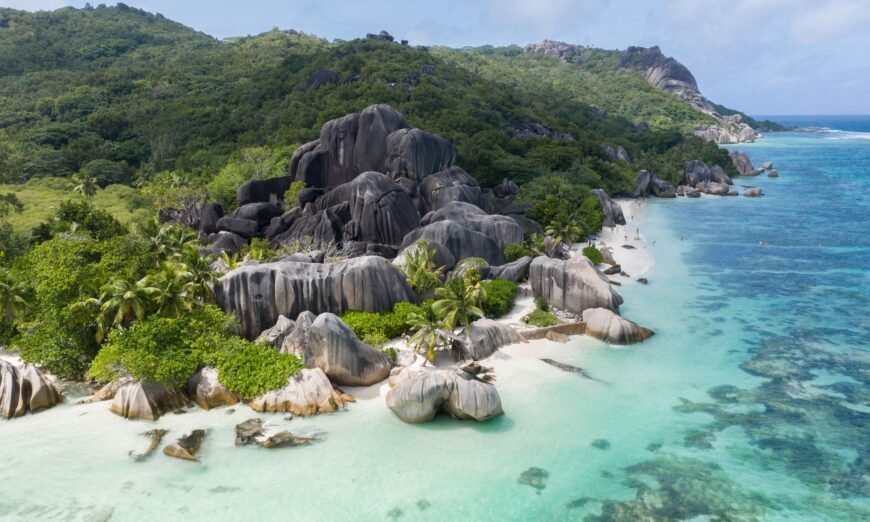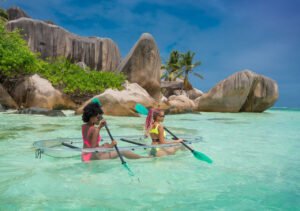
La Digue is the third most populated island of the Seychelles, and fourth largest by land area, lying east of Praslin and west of Felicite Island. In size, it is the fourth-largest granitic island of Seychelles after Mahé, Praslin, and Silhouette Island. It has a population of 2,800 people. Most of the inhabitants live in the west coast villages of La Passe (linked by ferry to Praslin and Mahé) and Anse Réunion. It has an area of 10.08 km2, making it relatively easy to travel by bike or on foot.
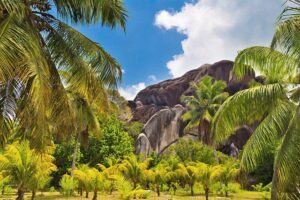
According to historian Julien Durup, a native of La Digue, explorer Lazare Picault spotted the island in 1742. However, it was not named until 1768, after a 360-ton ship under the command of navigator Marc-Joseph Marion du Fresne.
The first settlers on La Digue – French colonists with African slaves – arrived in 1789. The majority returned to France, but during the decades that followed the island became home to many liberated slaves, French deportees and Asian immigrants. These early islanders earned their living through making copra from coconuts and growing vanilla on their plantations. This tradition continues to the present day, but tourism is the principal industry.
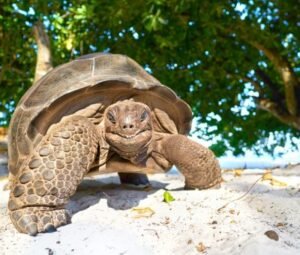
Unlike Mahe or Praslin, there is no airport on La Digue. However, there are regular ferry transfers with Mahe and Praslin. A trip to or from Mahe takes around 1h 45 min, in a comfortable high-speed ferry. The trip from Praslin takes only 15 min. The ferry terminal of La Digue is located in La Passe, the main village of the island, where you can find a handful of souvenir shops, seafood restaurants, and mini supermarkets.Very few cars are permitted on the island and it is more usual to see oxcarts rumbling along the roads. We recommend hiring a bike to explore the island. From the sleepy village of La Passe to L’Union Estate & Copra Factory to Veuve Nature Reserve with its magnificent black paradise flycatchers, there is plenty to discover here. While ferries to neighbouring island Praslin are frequent – and from Praslin, it is possible to take a trip to Mahé.
Anse Source d’Argent on La Digue is known as one of the most beautiful beaches in the world. It is easily accessible by bike and the route there is sensational, cycling through a nature reserve, as well as through the coconut and vanilla plantations whose deliciously sweet smell moves gently with the breeze. The beach lives up to its reputation entirely. Huge carved granite rocks border Anse Source d’Argent, and the calm coral-filled water goes on for what appears to be an eternity. The sculpted silhouettes of neighbouring islands provide a dramatic backdrop to this remarkable and breathtaking beach. It’s open to all, and although it’s popular there is room for everyone to enjoy this spot.
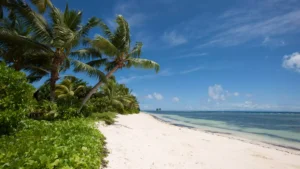
Anse La Réunion lies on the west coast of La Digue, near to a number of popular accommodations, such as La Digue Island Lodge and Le Surmer Chalets. In terms of variety, Anse La Réunion is one of the best beaches on La Digue. Perfect for families thanks to the shallow water and ample shade, visitors can also enjoy swimming in the water or snorkelling. The beach is also great for sunset strolls, with the fading light of day disappearing behind Praslin, making for some spectacular vistas. And, as the beach is located near to a number of shops and restaurants, its facilities are second-to-none on La Digue. Despite all of this, the beach is usually empty, besides the sections directly in front of guesthouses, so it never feels crowded or busy.
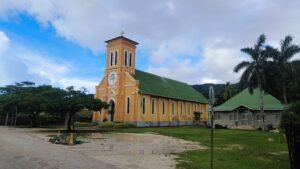
At the southern end of La Réunion, cross over to the L’Union Estate, a former coconut and vanilla plantation that is a real insight into La Digue colonial history. At the end of the coastal road, behind a footpath, begins this park/coconut plantation. Until the 1980s, coconuts were actually grown here in the fields, and copra (the dried flesh from which coconut oil is processed) produced.Of further historical significance is the old cemetery, which is also located on the L’Union Estate, and can even be visited. The first settlers of La Digue are buried at this location. Besides that, the Aldabra Giant Tortoise enclosure is another popular tourist attraction. Unfortunately, the animals are always kept inside this enclosure, in contrast to Curieuse Island, a nearby nature reserve where they can roam free. Near the tortoise enclosure is the vanilla plantation. This was another plant that used to be grown on La Digue, but due to the lack of pollinating insects on the island, the pods can only be harvested if humans pollinate each flower individually by hand.Neighbouring the vanilla plantation is a 40-metre monolith in the sky. The Giant Union Rock occupies an area of 4,000 m², and is estimated to be around 700 million years old.
Le Digue is composed primarily of massive granite fragments of the ancient supercontinent of Gondwana. The granite is everywhere, jutting skywards from the beach, and even greeting as sheer cliff. These islands are the only oceanic islands in the world formed of granite, and, if that wasn’t enough to pique a Geologist’s interest, they are also the world’s oldest islands. It’s the only place you can find these massive granite boulders in a tropical setting, and the rock is everywhere…in the form of massive boulders on the beach, as massive vertical cliffs, and even scattered throughout the cities themselves. The place can really only be described as a tropical Yosemite Valley.
Visitors must take note of some of the most famous hotels and resorts on the island as well. Built in 1973, La Digue Island Lodge is the first hotel of La Digue Island, nestled amongst lush tropical gardens and a beautiful sandy stretch of beach of Anse Réunion, home to the national monument of Seychelles, the Colonial Yellow House. The hotel is also well known for its iconic A-frame chalets and as a traditional Creole resort on the island of La Digue. Couples can enjoy intimate, exclusive settings while families and children have ample space to explore and be active. Cocktails can be enjoyed with colourful sunset painted skies, while lounging on the beach or pool deck and experience authentic Creole cuisine Anse aux Cèdres is located in the south of La Digue, about 30 minutes on-foot from Anse Union. The mixture of tall waves, granite boulders, coral reef, and sea-shells dotting the sand make this beach a unique natural prospect, with some great opportunities for photographers thanks to the interplay between the sand, the ocean, and the rocks.
Some well-known restaurants in La Digue that one must explore include Le Duc de Praslin, well-known by locals as a gourmet restaurant. Besides its great beach location and the artistic decoration, the delicious food here is the real star of the show. Other includes the Marie Antoinette, one of the oldest and best-loved restaurants in the Seychelles. It has been serving up delicious Creole cuisine since it opened its doors in 1972, unleashing its rustic living-room atmosphere on the world.
The centre of the island has its own small nature reserve, the Veuve Reserve. This is the breeding ground of the Seychelles Paradise Flycatcher – a rare and endemic species, which immediately catches the eye thanks to its deep blue colour. Due to deforestation or alterations made by the cultivation of plants, it was decided to create a protective refuge for the birds. In 1982, the 21-hectare Veuve Reserve in the south of La Digue was born. There are several rangers who guard the area and bird experts who monitor the development of the birds, along with turtles, swiftlets, and other bird species.

